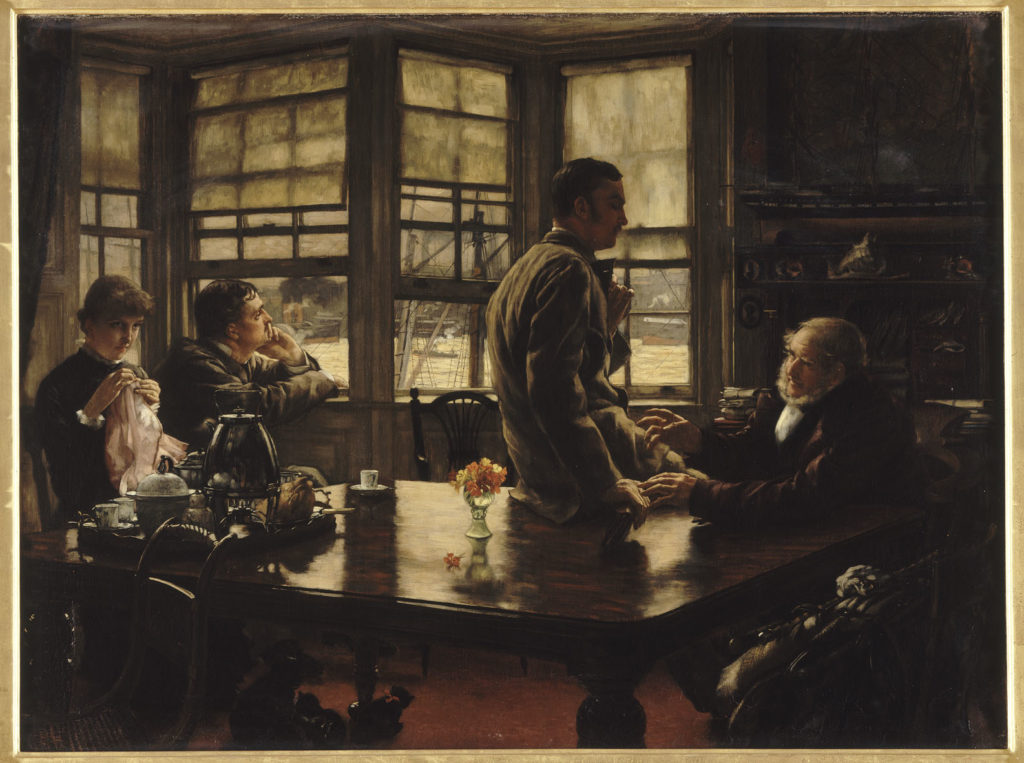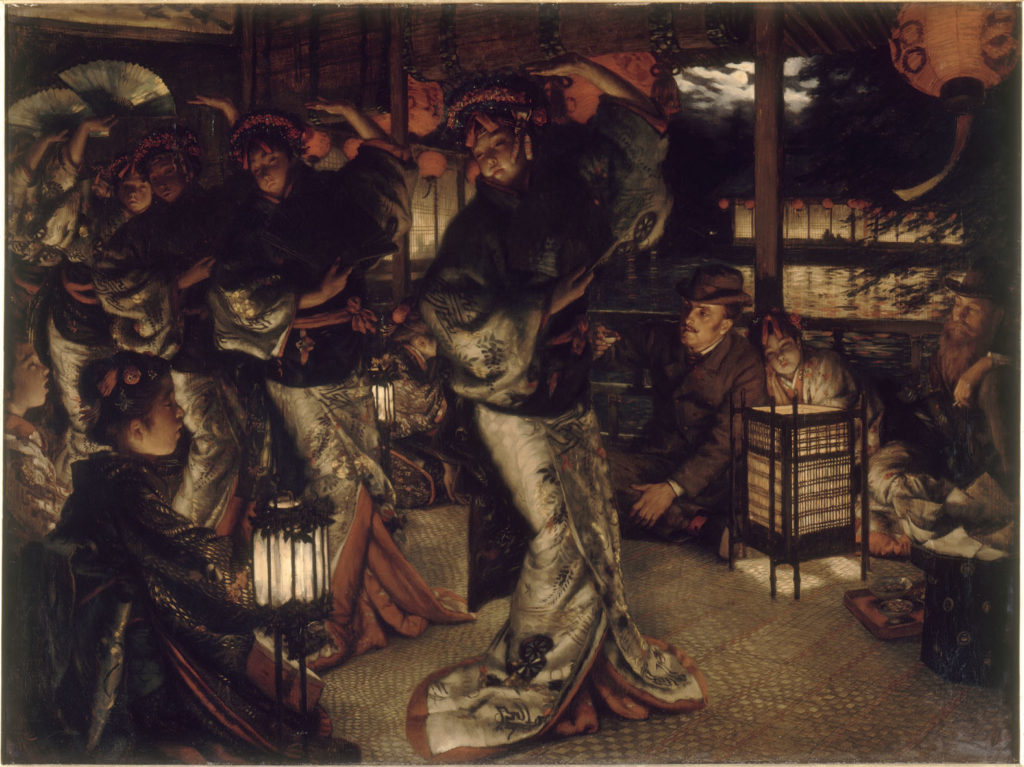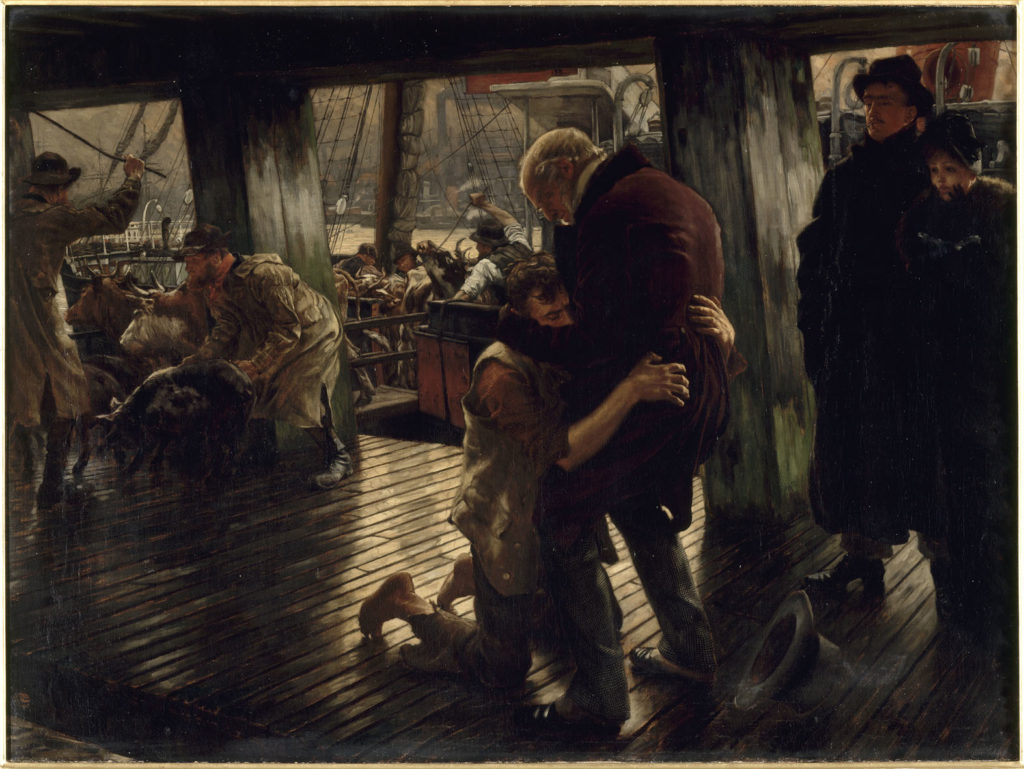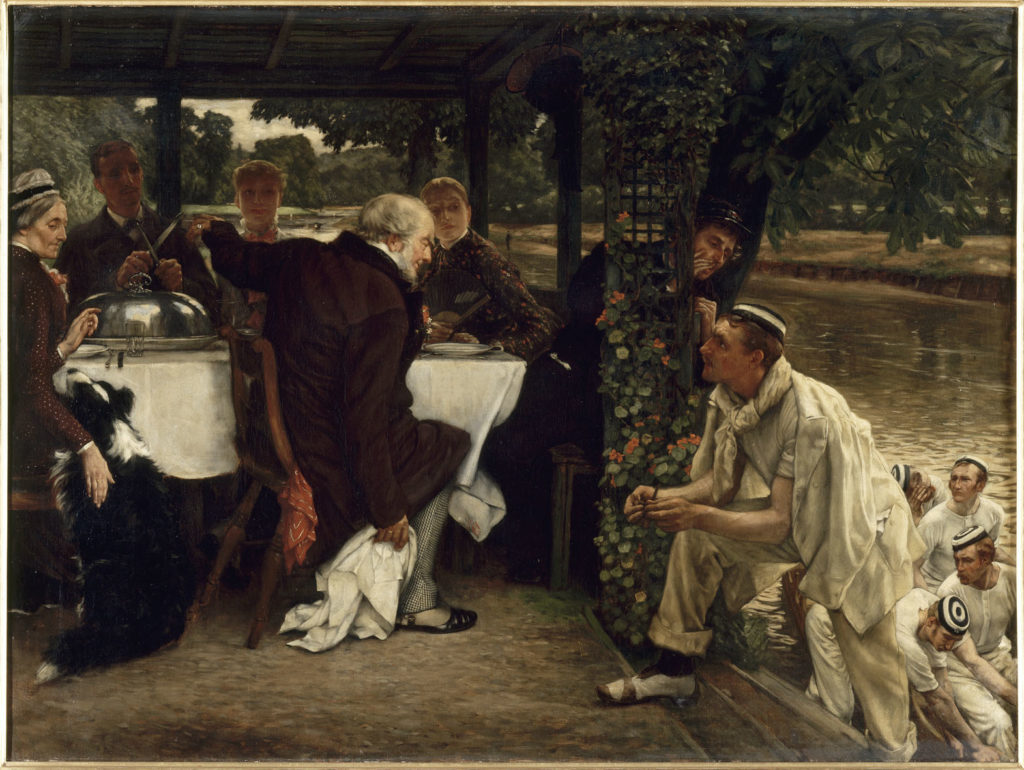Parenting and Property: the Prodigal Son in Modern Life
The steady stream of Boomer vs. Millennial conflict content that has permeated the news for the past couple of years is nothing new, in broad terms—history is littered with older generations bemoaning younger generations’ willingness to let go of certain traditions, while younger generations roll their eyes at their elders’ refusal to progress. But the Boomer vs. Millennial situation is unique in that Millennials (full disclosure: a group that includes the author) have recognized not just Boomers’ desire to maintain the status quo, but also the ongoing consequences of that status quo. Boomers, many Millennials contend, have a deep misunderstanding of how their decisions thirty to forty years ago affected the current state of jobs, housing, politics, and society in general.[1] They are stubbornly unaware of their impact on the world, Millennials say, and resentful of those who try to spark awareness in them. Millennials, some Boomers say, are overly sensitive, have mixed-up priorities, and expect “participation trophies.”[2]
Among the generational shifts documented in the US is the shrinking number of people with religious affiliations. According to a 2018-2019 Pew Research survey,[3] 65% of American adults describe themselves as Christian, a twelve point decrease from the previous decade. Broken down by generation, around 76% of Boomers identify as Christian, compared to only 49% of Millennials.3 News outlets have reported on this data, and similar conclusions by other think tanks, with a particular narrative in mind. With titles like: “Is it Baby Boomers’ Fault Millennials Are Leaving Religion and Less Likely to Go Back?” (The Federalist), and “Will Baby Boomers Ever Find Religion?” (Psychology Today), these pieces heavily imply that the story of Boomers’ departure from, and return to, religion, as well as Millennials’ current withdrawal from organized worship, parallel a narrative that is inextricably tied to religion—the parable of the Prodigal Son. The questions of empathy and forgiveness that swirl around such thinkpieces have also long been at issue in Christian theology, and particularly in the Prodigal Son story, told by Jesus himself in Luke 15:11-32. The parable has become almost archetypal over time, the very phrase “the prodigal son” weaving itself into the Anglo-American vocabulary and becoming a common idiom for children who disobey their parents. Over the centuries, European and American artists from Rembrandt to Beckmann have illustrated the parable, or episodes from it, in their own particular styles, but usually keep it within its first-century Middle Eastern context. In the 1880s, however, artist James Jacques Tissot reimagined four episodes from the parable “in modern life,” depicting the titular son, his forgiving father, and his frustrated older brother in nineteenth-century clothes amid a world of steamships, global travel, and industrialized capitalism. By taking the parable out of the first-century context in which it originated, Tissot effectively reimagines the story through his specific approaches to characters, setting, and narrative pacing. Tissot’s reimagining is no longer primarily an analogy for God’s forgiveness as in the original parable, but rather a depiction of a familial and intergenerational conflict centered around the fair distribution of wealth and property. By considering Tissot’s four paintings in the fullness of their rich detail, we see that his version of the Prodigal conflict is more than just a lesson about forgiveness—it is a lesson about effective parenting, and respect for the future of one’s children, that resonates even today.
James Jacques-Joseph Tissot (French, 1836-1902) is best known for his paintings of beautiful women and society figures in 19th century Europe. The series of paintings that preceded the Prodigal Son series, called Femme à Paris, depicted glamorous French society women, by no means a philosophically complex series. But it was apparently during the production of this Women of Paris series that Tissot had a “religious revelation” which altered the focus of his body of work considerably.[4] After this revelation Tissot became increasingly focused on Christian subject matter, and the Prodigal Son series became the prelude to an expansive series of watercolors based on the life of Jesus Christ, which totaled 365 individual works when he was finished.[5] But while the Life of Christ series aimed to be “authentic” to the ancient Middle Eastern context of Jesus of Nazareth’s life, the Prodigal Son in Modern Life was “prompted by an interest in easily legible narrative painting” and didn’t aim for historical accuracy.[6]
For those unfamiliar with the parable, a synopsis: a younger son asks his father for his inheritance early, subsequently uses up all the money on traveling and “riotous living,” and after sinking to the low position of swineherd in order to get by, returns to his father to ask forgiveness for his wastefulness. The father, overjoyed that his son has returned, not only forgives him, but arranges a feast in his honor, for which he slaughters a fatted calf (an animal being raised as meat for a very special occasion). The older brother, who has remained by his father’s side, is bewildered by the attention being paid to his wastrel brother, and asks why his father did not ever celebrate him. The father replies that celebrating the younger brother is only right, because “this thy brother was dead, and is alive again; and was lost, and is found.” (Luke 15:32, KJV) This story is one of three stories of forgiveness that Jesus tells to illustrate God’s willingness, indeed even eagerness, to forgive those who stray from the righteous path. Tissot’s series condenses this parable into four key scenes: the prodigal son’s departure, where he asks his father for money; the prodigal son “in foreign climes,” wasting that money; the return of the prodigal son to his father; and the moment at the feast when the older son confronts his father. These four scenes, rather than taking place in the ancient Middle East, instead take place in 19th century England (and Japan, for the second scene). This “reboot” of the parable in modern times allows Tissot the opportunity to suffuse his scenes with rich and highly specific detail, from the clear representation of the Thames in the background of scenes one, three, and four, to the inclusion of a sister or sister-in-law as well as a mother, neither of whom appear in the original parable.[7] By elaborating upon the framework of the original story beyond just setting it in a different time and space, Tissot adds layers of meaning that are absent from the original story and opens up new lines of questioning about the story as a narrative in and of itself, rather than as a parable.

James Tissot, The Prodigal Son in Modern Life: The Departure, 1880, oil on canvas,
86.4 x 115.9 x 2.5 cm. Image courtesy of Cécile Clos/Musée d’arts de Nantes.
The first scene, The Departure, takes place in an office that overlooks the busy Thames, and Tissot seems to depict the distribution of inheritance as having already taken place: the prodigal son, sitting on the table in the center of the room, looks down his nose at his father as he clutches a billfold in his right hand and pulls his left hand tight to his chest, as though recoiling from his father’s own outstretched hands. The older son, the one who will remain with his father, gazes wistfully out the open window of the office with his chin in his hand. A woman watches the exchange between the father and the prodigal as she sews, eyes fixed on the pair, invested in the action unfolding.
Even disregarding the more symbolic elements of the painting—the kitten straying from the litter under the table, the flower that has fallen from the bunch in the vase, the model ship and conch shell[8]—this is quite a bit more elaborate than the two-verse quote that describes the event in the parable, and that accompanied the print that was made of this painting:
And he said, A certain man had two sons. And the younger of them said to his father, Father, give me the portion of goods that falleth to me. And he divided unto them his living. (Luke 15:11-12, KJV)
The older son is barely mentioned in the text—perhaps he, too, receives his portion of the inheritance, but it’s never really made clear. Certainly, in Tissot’s painting, there is no exchange of money depicted or even implied with the older son, who appears idle and uninvolved with his father’s affairs. In William Marling’s economic reading of the Prodigal Son parable, he discusses Northrop Frye’s catalogue of varying attitudes to older sons in literature across time, from the Old Testament’s use of the “overthrow of primogeniture as a dramatic situation,” the jealous “older son, Lucifer” in Milton’s Paradise Lost, and the early- to mid-19th century Romantic movement’s interest in “rejected but at least quasi-tragic Biblical figures, who may be sent into exile and yet are in another context the rightful heirs.”[9] Yet, Tissot does not seem to depict these archetypes in The Departure: there is no sense that the older son is jealous or indignant, or even that he is in line to inherit his father’s business. He sits far off to the side, involved in his daydreams, while the desk behind his father is stuffed and piled high with papers, perhaps an indication of disorganized business affairs. This, combined with the rather guarded pose and expression of the younger (prodigal) son sitting on the table, suggests that this household is not functioning as a traditional patriarchal household ought to. Even within an ancient Middle Eastern Jewish context, the parable reveals deep flaws in the family dynamic, as Marling explains in his analysis.
The younger son’s request treats “his father as already dead…in the sense of no longer requiring a livelihood.” In the most prevalent legal arrangement, [James] Breech says, such an inheritance could not be given until the death of the father: “The storyteller calls the property the man’s living…. [T]he property provides the man with his means of livelihood and support.” In the thinking of the ancient world, Breech observed, “questions regarding ownership of property and questions regarding father-son relationships were inextricable. What the man does—allowing himself to be treated as though dead and giving away his proprietary rights—is utterly unparalleled in any of the parabolic narratives which survive from antiquity.”[10]
The father’s financial decision-making is bewildering, and it almost makes one wonder whether the father is doing this on purpose, manufacturing a lesson for the benefit of his sons. Olga V. Solovieva, writing in a blog post for the University of Chicago Divinity School, interprets the father’s generosity as a “blessing” of his son’s “entrepreneurial spirit,”[11] but it doesn’t seem in either the verse referenced or the details of Tissot’s painting that the son has entrepreneurial intentions. A suitcase and walking-stick are bundled up on the chair in the right lower foreground, indicating travel, but not necessarily business travel.

James Tissot, The Prodigal Son in Modern Life: In Foreign Climes, 1880, oil on canvas, 86.5 x 116 x 2.7 cm. Image courtesy of Cécile Clos/Musée d’arts de Nantes.
The evidence of the father’s poor investment is borne out in the second painting, In Foreign Climes, where the son is depicted sitting in a Japanese room, raising a cup of sake while being entertained by elaborately dressed Japanese dancers, possibly geisha. Another Japanese woman rests her head on his shoulder and a fellow European with a long red beard looks on with a cigarette dangling between his fingers. That Tissot chose Japan to represent the site where the prodigal son “wasted his substance with riotous living” is significant, in that it is arguably the most “foreign” place Tissot could have possibly chosen in 1880s Europe. After being forcibly opened up to trade and tourism through the efforts of Commodore Perry in 1854, the formerly isolated Japanese archipelago seemed like the ultimate novelty to Europeans. The subsequent international trade in Japanese prints had a huge impact on the development of the visual arts in Europe, and traveling exhibitions of Japanese culture such as the “Japanese village” in Knightsbridge, London, were incredibly popular (the Knightsbridge village is often cited as a major inspiration for W. S. Gilbert’s development of the extremely popular comic opera The Mikado in 1885). Japan was thus a natural choice for a “foreign clime” in which to depict the prodigal son “wasting his substance.” Furthermore, as a 1999 monograph of Tissot’s works emphasizes, “as a non-Christian land, Japan also illustrated the Prodigal’s deviation from God,” and “middle-class Victorians tended to view the Japanese people as hedonistic, irresponsible, and unethical.”[12] The sense of the prodigal son’s dissipation is thereby enhanced by his placement in a Japanese context. However, this choice has little bearing on the rest of the series: we see no hints of japonaiserie in the paintings that follow, nothing to suggest that the prodigal son has taken anything with him specific to his Japanese travels, or that Japanese culture specifically had any role in his downfall. The choice of Japan as the site of prodigality seems to have been largely a convenient and topical choice.

James Tissot, The Prodigal Son in Modern Life: The Return, 1880, oil on canvas, 86 x 115.7 x 3 cm. Image courtesy of Cécile Clos/Musée d’arts de Nantes.
The shift from In Foreign Climes to The Return skips over a major section of the parable narratively, though the text is included with the print version of The Return: the son has sunk to the unenviable level of swineherd, and nearly resorted to eating the pigs’ cast-off food in his hunger, before deciding to return home and beg his father’s forgiveness. For viewers of the painting, however, this is not necessarily made clear. In the background behind the embracing father and son, two workers are driving animals, mainly cattle with only one visible pig, off a ship and onto the dock. There is no clear association made between the prodigal son and the livestock, and as such, without the caption that accompanies the print version of this image, there is little sense of the extent of the son’s prodigality. He is barefoot as he kneels before his father, in simple clothing, but this is a generic (and frankly, rather cleaned-up) depiction of poverty. Perhaps the most fascinating element of the painting, especially for our purposes, is the loyal son, standing stoically off to the side accompanied by the same woman who was next to him in the first image. The loyal son has a rigid pose, entirely enveloped in his overcoat, his expression disapproving as he puffs on a cigarette. The woman next to him has a rather theatrical expression of surprise as she watches the reunion of the father and the prodigal, her lips slightly parted and her gloved hands held up to her face. Once again, as in the first scene, we have no sense of what the older son has been doing while he has remained with his father. Our focus is supposed to be on the touching reunion at the center of the painting, but the inclusion of the loyal son off to the side involves him in the narrative Tissot constructs to a greater degree than in the parable, and the manner of his inclusion casts into doubt his role in the family and the implications of his father’s now-clear favoritism for the younger of his two sons. The older son is no longer idle and daydreaming as in The Departure, but he is nonetheless set apart from the action of the story, despite the fact that it is his conflict with his father that will ultimately prompt the delivery of the story’s moral.

James Tissot, The Prodigal Son in Modern Life: The Fatted Calf, 1880, oil on canvas, 86,3 x 116.2 cm. Image courtesy of Cécile Clos/Musée d’arts de Nantes.
The fourth and final image in the series, The Fatted Calf, illustrates the scene of the parable in which the moral is most plainly spelled out, and the confrontation that has become a sticking point for a number of commentators. The father and the prodigal son are sitting down to a meal along with two women, a man in some kind of military garb, and the mother of the family, who has been absent from the rest of the story until now. The older, loyal son, dressed in boating gear, steps off a boat filled with other sportsmen and leans forward to confront his father as to why he was never celebrated as his brother was despite having done his father’s bidding. The father looks at and speaks to the loyal son, but gestures towards the prodigal son, who is sharpening a knife to cut something under a dish with a silver cover.
The specific details in this scene as depicted by Tissot alter both the narrative pacing and the characterizations established in the original parable. While The Departure and The Return took place in a more industrialized setting, the setting for The Fatted Calf is rural, which implies a much greater move in time and space than between these two scenes in the parable itself:
And he arose, and came to his father. But when he was yet a great way off, his father saw him, and had compassion, and ran, and fell on his neck, and kissed him. And the son said unto him, Father, I have sinned against heaven, and in thy sight, and am no more worthy to be called thy son. But the father said to his servants, Bring forth the best robe, and put it on him; and put a ring on his hand, and shoes on his feet: and bring hither the fatted calf, and kill it; and let us eat, and be merry…And they began to be merry. Now his elder son was in the field: and as he came and drew nigh to the house, he heard musick [sic] and dancing. (Luke 15:20-25, KJV)
All of these events—the return, the forgiveness, the beginning of the confrontation by the elder son—appear to occur in the parable in the same location, the father’s estate. In Tissot’s version, however, the return occurs on the docks, and the forgiveness celebration and confrontation occur in a different location entirely, perhaps the father’s country estate. While it is possible that the elder son, working in the field, would not have known about his brother’s return or the celebration, in Tissot’s 19th century retelling, the elder son was present at the reunion, and presumably traveled with the father and the prodigal to the country estate. The confrontation that occurs in Tissot’s series, therefore, is not an instantaneous jealousy (“And he was angry, and would not go in”) but something that came after a greater amount of thought. Tissot’s older son appears frustrated, but not necessarily petulantly angry as he does in the parable. Indeed, he was frustrated when he appeared in The Return—this is something that has been stewing for some time. There seems, therefore, to be a greater sense of righteousness, even justification, about the older son’s reaction in Tissot’s series. Looking at the older son’s three appearances in relation to one another, it’s clear that he is consistently set apart from the family and its business dealings for some reason. He daydreams while in his father’s office, takes a stoic stance off to the side at his brother’s return, and rather than being involved in the celebratory feast, is off sporting until he decides to confront his father. Why is the eldest son of a wealthy Victorian businessman not more involved with his family and their business affairs? Again, we are confronted with the realization that this family is not functioning as an ideal patriarchal family ought.
Theologist Dr. Susan Eastman recognizes these familial difficulties in an article on the Prodigal Son parable, ultimately arguing that the resolution[13] of the parable is achieved through “divine wisdom, masquerading as foolishness” on the part of the father.[14] She acknowledges that “the exemplary prodigal father was, to all appearances, a resounding failure as a parent,” and that “it is not ‘fair’ or ‘equal’ when the wastrel son is invited in to share the older son’s part in the inheritance. The father simply is not keeping count. Rather he operates by an economy of grace, in contrast with the zero sum economy of the elder brother…”[15] This “economy of grace” works for the purposes of Jesus’s parable, but it doesn’t necessarily work in the context of Tissot’s paintings, where the pacing, characterizations, and specific details pull away from the moralizing teleological trajectory of the parable. For instance, we see the father’s neglect of the older brother and the attention he pays to the younger one, but we do not see the reward for the younger son’s return: the fatted calf. The prodigal son is sharpening his knife to cut something, but there is no visible food on the table, only a large covered dish. The very title of the painting is not visible in the scene, and as so many of the details in these paintings have cast doubt upon the straightforwardness of the narrative, this detail, too, or rather the lack of it, casts doubt on whether there is a reward at all.
Eastman frames her description of the “prodigal father” being a “resounding failure as a parent” in terms of the realization she had upon rereading the parable after her own children had left home.[16] New context, for her, allowed her to see the parable in a new light, not as a straightforward moral lesson, but as a more complex tale of a fractured family led by an irresponsible patriarch. While Tissot created his Prodigal Son series in the late 19th century, its intricacies and complexities become especially relevant in light of the primary generational conflict of our current moment, which in itself can be seen as an amplified version of many previous intergenerational conflicts. Many Millennial criticisms of Baby Boomers focus on Boomers’ “short-sighted decisions” and poor understanding of why such decisions have made the world less equitable and survivable.[17] To reframe this within the metaphor of the parable: Boomers slew the fatted calf and congratulated themselves on doing so, and when Millennials asked why, they were given lessons and moralizing rather than real answers or admissions of fault.
To extend the metaphor further, Baby Boomers could be seen as prodigal children in and of themselves. They rejected the social mores of their parents, the Greatest Generation, and “wasted [their] substance with riotous living,” most clearly in the form of the counterculture of the 60s and 70s. Stephen Metcalf’s 2016 article in Slate on Donald Trump as a product of the Baby Boomer generation also points out another prodigal tendency among Boomers: draft evasion.[18] Boomers, he says, “were made a generation by a war they did not fight; a war, in fact, they evaded fighting…. Of those 27 million [draft-eligible American men], 11 million were called up [to fight in Vietnam], and only 1.6 million saw combat duty…. Draft evasion became something of a cottage industry.”[19] But this shirking of duty, however righteous, did not affect the financial rewards Boomers later reaped. As Ruy Teixeira of the Center for American Progress says in a 2019 Politico piece, Boomers “grew up in an era when there was something close to full employment almost all the time. Wages were going up with productivity, and productivity was going up very fast. Incomes were growing at the rate of 2 percent a year, something that we haven’t seen since….”[20] Boomers’ prodigality was rewarded with financial security and even wealth, but rather than channeling that reward into similar security for their descendants, they supported short-sighted policies that prevented successive generations from seeing those same rewards, regardless of whether or not they, too, behaved prodigally. As Teixeira continues: “The baby boom happened to get older at the same time that America adopted an economic model that was actually pretty counter-productive, which did not actually produce rising wages and incomes for people at a very good clip, that enhanced inequality.”[21]
The generational conflict between Boomers and Millennials, and the way in which Tissot constructs his new version of the Prodigal Son parable, augment one another when viewed in tandem. A Millennial perspective on the priorities of older generations, when turned upon Tissot’s work, amplifies the problematic aspects of the prodigal father’s parenting as well as revealing the inability to reconcile a dysfunctional patriarchal family structure with unconditional love, forgiveness, and grace. The details of Tissot’s paintings and the way in which he recasts the Prodigal Son parable, particularly in The Fatted Calf, mirror and highlight the nature of the conflict between Millennials, who question whether older generations’ decisions were fair and equitable, and Boomers, who see their logic as unimpeachable and younger generations as missing the point. While the Prodigal Son parable itself is not necessarily analogous to the Boomer-Millennial conflict, the way in which Tissot recasts the story in a Victorian context draws it closer to being so. The Victorian era, wherein our modern white supremacist capitalist patriarchy (to borrow a term from bell hooks) became more concretely formed, provides a more familiar backdrop for the narrative, both for the Victorians who initially viewed it, and for us as 21st century viewers.
[1] “‘OK Boomer’ Has the Internet in a Tiff. How Did We Get Here?,” NBC News, accessed November 20, 2019, https://www.nbcnews.com/better/lifestyle/ok-boomer-diving-generation-what-does-it-mean-ncna1077261.
[2] Aja Romano, “‘OK Boomer’ Isn’t Just about the Past. It’s about Our Apocalyptic Future.,” Vox, November 19, 2019, https://www.vox.com/2019/11/19/20963757/what-is-ok-boomer-meme-about-meaning-gen-z-millennials.
[3] “In U.S., Decline of Christianity Continues at Rapid Pace,” Pew Research Center, October 17, 2019, https://www.pewforum.org/2019/10/17/in-u-s-decline-of-christianity-continues-at-rapid-pace/
[4] Willard E. Misfeldt, “Tissot, James,” in Oxford Art Online (Oxford University Press, 2003), https://doi.org/10.1093/gao/9781884446054.article.T085236.
[5] Misfeldt.
[6] Nancy Rose Marshall and Malcolm Warner, James Tissot: Victorian Life, Modern Love (New Haven: American Federation of Arts, Yale University Press, 1999), 163
[7] Marshall and Warner, 165-166.
[8] Marshall and Warner, 166.
[9] William Marling, “The Parable of the Prodigal Son: An Economic Reading,” Style 26, no. 3 (1992): 422.
[10] Marling, 423.
[11] Olga V. Solovieva, “The Pitfalls of Meritocracy: James J. Tissot’s ‘Prodigal Son’ Etchings at the Smart Museum,” University of Chicago Divinity School (blog), May 28, 2015, https://divinity.uchicago.edu/sightings/articles/pitfalls-meritocracy-james-j-tissots-prodigal-son-etchings-smart-museum
[12] Marshall and Warner, 166.
[13] I hesitate to call it a resolution, as we don’t get any sense that the older son accepts his father’s reasoning or that the family is all reunited together.
[14] Susan Eastman, “The Foolish Father and the Economics of Grace,” The Expository Times 117, no. 10 (July 2006): 405, https://doi.org/10.1177/0014524606067176.
[15] Eastman, 402, 404.
[16] Eastman, 402.
[17] Romano, “OK Boomer.”
[18] Stephen Metcalf, “Donald Trump, Baby Boomer,” Slate, May 1, 2016, http://www.slate.com/articles/news_and_politics/cover_story/2016/05/donald_trump_baby_boomer_how_the_candidate_was_shaped_by_his_generation.html.
[19] Metcalf.
[20] Ben White, “How the Baby Boomers Broke America,” POLITICO, accessed December 28, 2019, https://www.politico.com/news/2019/10/26/how-the-baby-boomers-broke-america-058122.
[21] Ben White, “How the Baby Boomers Broke America.”



Dilettante Mail
Get updates from us a few times a year.